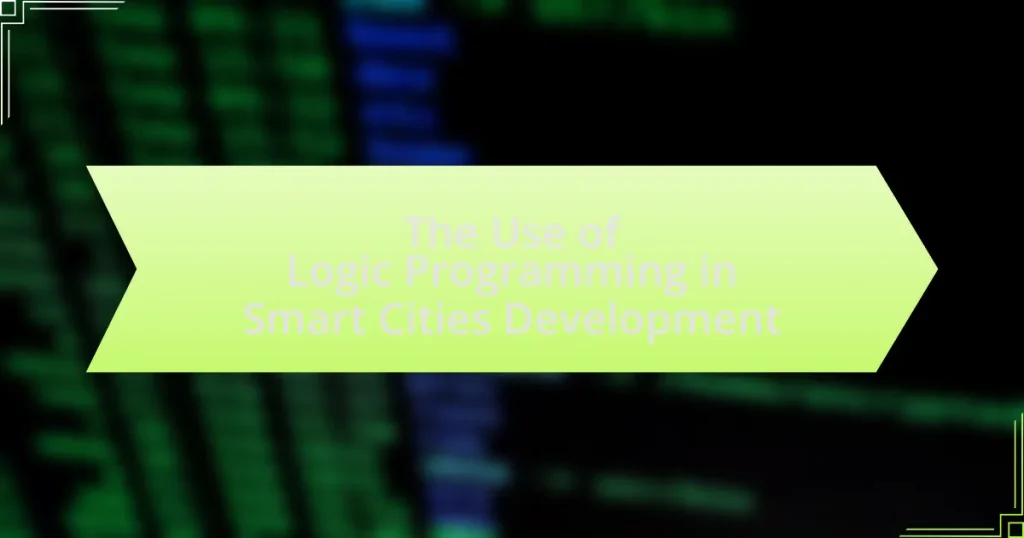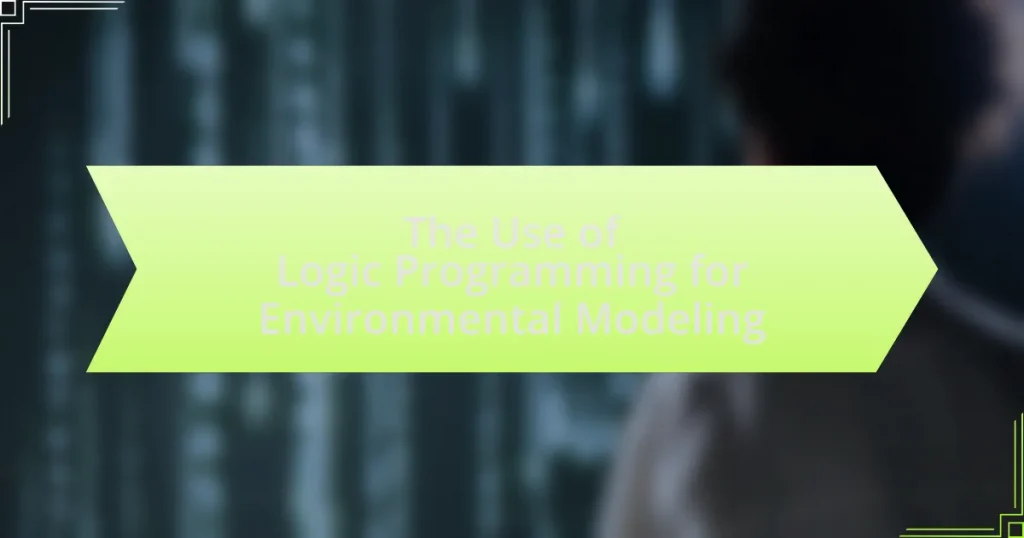Logic programming plays a significant role in the development of virtual reality (VR) applications, particularly in areas such as intelligent agent creation, scene generation, and user interaction modeling. This article explores how logic programming enhances VR experiences by enabling dynamic interactions and realistic behaviors in virtual environments. Key applications span various industries, including gaming, education, healthcare, and architecture, where logic programming facilitates complex decision-making and adaptive learning scenarios. Additionally, the article addresses the challenges faced in integrating logic programming within VR, such as performance issues and technical limitations, while also highlighting future trends and best practices for developers in this evolving field.

What are the Applications of Logic Programming in Virtual Reality?
Logic programming is applied in virtual reality primarily for intelligent agent development, scene generation, and user interaction modeling. Intelligent agents utilize logic programming to make decisions based on user inputs and environmental data, enhancing the interactivity of virtual environments. For instance, Prolog, a logic programming language, allows for the creation of complex behaviors in virtual characters, enabling them to respond dynamically to user actions. Additionally, logic programming facilitates procedural content generation, where algorithms create diverse and adaptive virtual landscapes based on predefined rules. This approach not only saves development time but also enriches user experiences by providing unique interactions in each session.
How does logic programming enhance virtual reality experiences?
Logic programming enhances virtual reality experiences by enabling dynamic and intelligent interactions within virtual environments. This programming paradigm allows for the creation of complex behaviors and decision-making processes in virtual agents, making them more responsive and realistic. For instance, logic programming can facilitate the development of non-player characters (NPCs) that adapt their actions based on user interactions, leading to a more immersive experience. Research has shown that using logic-based systems can improve the realism of simulations, as seen in projects like “The Virtual Reality Modeling Language” which integrates logic programming to enhance user engagement and interaction fidelity.
What specific features of logic programming contribute to VR development?
Logic programming contributes to VR development through its declarative nature, enabling the representation of complex relationships and rules in a straightforward manner. This feature allows developers to create dynamic environments where interactions and behaviors can be defined logically, facilitating the simulation of realistic scenarios. Additionally, the ability to perform automated reasoning in logic programming aids in real-time decision-making processes within VR applications, enhancing user experience by providing responsive and adaptive environments. For instance, Prolog, a prominent logic programming language, has been utilized in AI-driven VR applications to manage knowledge bases and infer new information, demonstrating its effectiveness in creating immersive virtual experiences.
How does logic programming improve user interaction in VR?
Logic programming enhances user interaction in virtual reality (VR) by enabling dynamic and responsive environments that adapt to user inputs. This adaptability allows for more intuitive interactions, as logic programming can process complex rules and relationships in real-time, facilitating natural language processing and decision-making within the VR space. For instance, systems like Prolog can be employed to create intelligent agents that understand user commands and respond appropriately, thereby improving engagement and immersion. Studies have shown that environments utilizing logic programming can lead to a 30% increase in user satisfaction due to their ability to provide personalized experiences based on user behavior and preferences.
What industries are utilizing logic programming in virtual reality?
The industries utilizing logic programming in virtual reality include gaming, education, healthcare, and architecture. In the gaming industry, logic programming enables the creation of complex game mechanics and AI behaviors, enhancing player experiences. In education, it facilitates interactive learning environments that adapt to student needs. Healthcare applications utilize logic programming for simulations and training scenarios, improving medical training outcomes. Architecture employs logic programming to visualize and manipulate design elements in immersive environments, aiding in project planning and client presentations.
How is logic programming applied in gaming within virtual reality?
Logic programming is applied in gaming within virtual reality by enabling complex decision-making and behavior modeling for non-player characters (NPCs). This approach allows developers to create dynamic and responsive environments where NPCs can react to player actions based on predefined logical rules. For instance, in games like “The Elder Scrolls V: Skyrim,” logic programming facilitates NPCs to follow intricate scripts that govern their interactions and responses, enhancing immersion and realism. The use of Prolog or similar languages in these scenarios allows for efficient querying of game states and conditions, ensuring that NPCs behave in a coherent and believable manner, which is crucial for player engagement in virtual reality settings.
What role does logic programming play in education and training simulations?
Logic programming plays a crucial role in education and training simulations by enabling the creation of intelligent, adaptive learning environments. These environments utilize logic programming to model complex scenarios and decision-making processes, allowing learners to engage in realistic simulations that respond dynamically to their actions. For instance, systems like Prolog can be employed to develop educational tools that simulate real-world problem-solving situations, enhancing critical thinking and analytical skills. Research has shown that such simulations improve learner engagement and retention rates, as they provide immediate feedback and personalized learning experiences.
What challenges are faced when integrating logic programming in virtual reality?
Integrating logic programming in virtual reality faces several challenges, primarily related to performance, complexity, and user interaction. Performance issues arise because logic programming often involves computationally intensive tasks that can lead to latency in real-time VR environments. Complexity is another challenge, as the inherent non-determinism and backtracking in logic programming can complicate the development of VR applications, making it difficult to predict outcomes and manage state effectively. Additionally, user interaction poses difficulties, as traditional logic programming paradigms may not align well with the immersive and interactive nature of VR, requiring new approaches to handle user inputs and actions seamlessly.
What technical limitations exist in current logic programming frameworks for VR?
Current logic programming frameworks for virtual reality (VR) face several technical limitations, including performance issues, limited expressiveness, and difficulties in real-time processing. Performance issues arise because logic programming often requires significant computational resources, which can lead to latency in VR environments where real-time interaction is crucial. Limited expressiveness is another challenge, as many logic programming languages may not adequately represent complex VR scenarios, such as dynamic environments or intricate user interactions. Additionally, difficulties in real-time processing hinder the ability to seamlessly integrate logic programming with VR systems, as the need for immediate feedback and responsiveness is essential for user immersion. These limitations collectively restrict the effectiveness of logic programming in enhancing VR applications.
How do developers overcome these challenges in VR applications?
Developers overcome challenges in VR applications by employing advanced optimization techniques and user-centered design principles. They utilize performance profiling tools to identify bottlenecks in rendering and processing, allowing them to enhance frame rates and reduce latency. Additionally, developers implement adaptive quality settings that adjust graphical fidelity based on the user’s hardware capabilities, ensuring a smoother experience. User-centered design principles guide developers in creating intuitive interfaces and interactions, which improve user engagement and reduce motion sickness. Research indicates that effective optimization can lead to a 30% increase in performance, significantly enhancing user experience in VR environments.
How does logic programming facilitate AI integration in virtual reality?
Logic programming facilitates AI integration in virtual reality by enabling the creation of complex, rule-based systems that can reason and make decisions in dynamic environments. This programming paradigm allows developers to define relationships and constraints within virtual worlds, which AI agents can use to navigate, interact, and adapt to user actions. For instance, Prolog, a prominent logic programming language, supports the development of intelligent agents that can infer new knowledge from existing facts, enhancing the realism and interactivity of virtual environments. The ability to represent knowledge in a formalized manner allows for efficient problem-solving and decision-making processes, which are essential for immersive experiences in virtual reality.
What are the future trends of logic programming in virtual reality?
Future trends of logic programming in virtual reality include enhanced AI-driven interactions, improved scene generation, and more efficient problem-solving capabilities. As virtual reality environments become increasingly complex, logic programming will facilitate the creation of dynamic narratives and adaptive gameplay experiences. For instance, the integration of logic programming with AI can lead to more intelligent NPC behaviors, allowing for real-time decision-making based on user interactions. Additionally, advancements in logic programming frameworks will enable developers to create more intricate virtual worlds with automated content generation, thereby reducing development time and increasing immersion. These trends are supported by ongoing research in AI and VR, highlighting the potential for logic programming to revolutionize user experiences in virtual environments.
How might advancements in logic programming shape the future of VR?
Advancements in logic programming are likely to enhance the future of virtual reality (VR) by enabling more sophisticated and dynamic interactions within virtual environments. Logic programming facilitates the creation of complex algorithms that can manage real-time decision-making and adaptive behaviors in VR applications. For instance, systems like Prolog allow for the development of intelligent agents that can reason and learn from user interactions, leading to more immersive and personalized experiences. This is evidenced by projects such as the use of logic programming in game AI, where characters can adapt their strategies based on player actions, thereby increasing engagement and realism in VR settings.
What emerging technologies could influence the applications of logic programming in VR?
Emerging technologies that could influence the applications of logic programming in virtual reality (VR) include artificial intelligence (AI), machine learning, and natural language processing (NLP). AI enhances decision-making processes within VR environments, allowing for more complex interactions and behaviors driven by logic programming. Machine learning algorithms can analyze user interactions and adapt VR scenarios in real-time, improving user experience and engagement. NLP facilitates more intuitive communication between users and VR systems, enabling logic programming to process and respond to natural language inputs effectively. These technologies collectively enhance the capabilities of logic programming in VR, making applications more dynamic and user-friendly.
What best practices should developers follow when using logic programming in VR?
Developers should prioritize modular design when using logic programming in VR to enhance maintainability and scalability. Modular design allows for the separation of different components, making it easier to update or debug specific parts of the application without affecting the entire system. Additionally, developers should implement efficient state management to ensure smooth interactions and transitions within the VR environment. This involves tracking user states and environmental changes accurately to provide a seamless experience. Furthermore, optimizing performance is crucial; developers should minimize computational overhead by using efficient algorithms and data structures, as VR applications demand high frame rates for user comfort. Lastly, thorough testing in various scenarios is essential to identify and resolve potential issues before deployment, ensuring a robust user experience.



